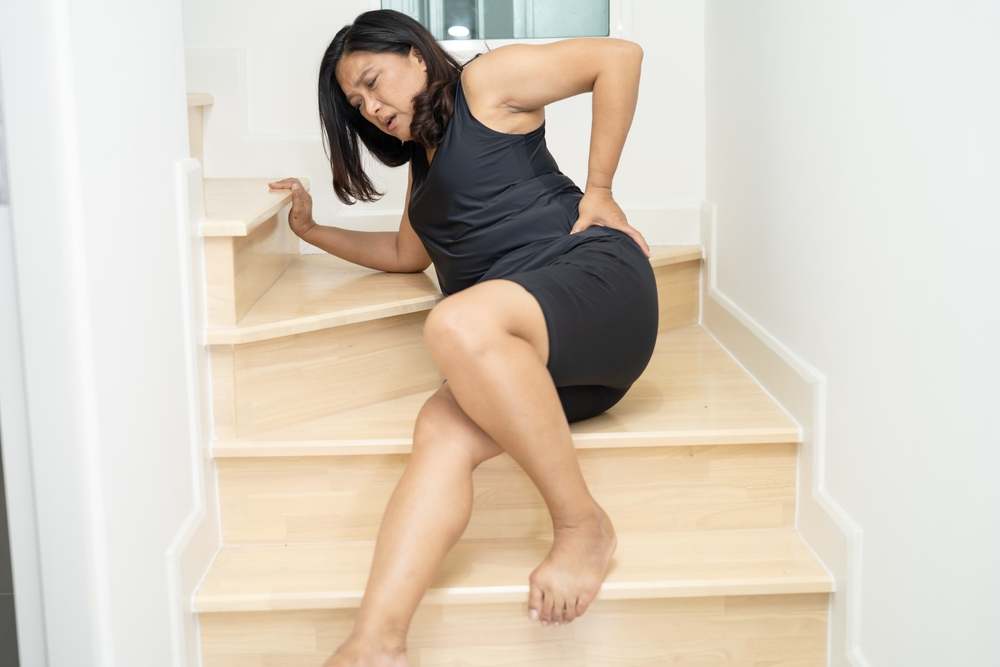The moments after a car accident or shocking injury are often confusing. They happen quickly and you might be disoriented, in pain, or even in an unfamiliar location. Once you get your bearings, if you don’t notice any immediately apparent injuries, you might handle the paperwork aspect of an accident with just a bit of rest. However, it is imperative to get a full evaluation after an accident, especially car accidents or after falling and hitting your head. Early evaluation after an accident is key to identifying internal injuries.
At AICA College Park, we specialize in treating injuries from sports, slips, falls, and car accidents with a comprehensive approach, starting with an evaluation and seeing you all the way through the healing process.
Causes of Internal Injuries
Blunt Trauma
This occurs when your body collides with another object, usually with excessive force. For example, you might get hit with a baseball bat during a game, or if you’re in a car accident and you hit the dash. The force of that hit can cause blood vessels and organs to be crushed or torn, resulting in internal bleeding.
Penetrating Trauma
This is when a foreign object is forced into your body, puncturing the skin, this is called a penetrating trauma. The foreign object can either stay lodged in your body or pass through, leaving an open wound. Penetrating traumas can occur during a fall or by flying debris during a car accident. Seeking post-accident medical care is vital as emergency responders may miss an internal injury while treating a penetrating injury.
Deceleration Trauma
This happens when your body, spine, and muscles come to an abrupt stop, like in a car accident, but other organs continue forward, striking a hard surface, like bone, inside your body. Decelerating trauma mostly impacts the heart, lungs, and brain. While traumatic brain injuries can occur when you hit your head, many are caused by the brain striking the inside of your skull and being bounced around. Decelerating trauma is often the most overlooked, as people don’t think they’ve been hurt if nothing hits them.
Falls and Slips
 Falls are one of the leading causes of emergency room visits and can often result in internal injuries as well as visible injuries. Preventing falls is often as simple as paying attention to your surroundings.
Falls are one of the leading causes of emergency room visits and can often result in internal injuries as well as visible injuries. Preventing falls is often as simple as paying attention to your surroundings.
Car Accidents
Over 2.1 million emergency department visits occurred for injuries from motor vehicle crashes in 2020. However, many victims show no outer signs of injury and may not feel symptoms for hours or days after a collision. This delay in treatment is dangerous and can result in severe health consequences.
Common Types of Internal Injuries
 While some internal injuries may not be immediately apparent, symptoms will develop and, depending on the severity, will indicate a course of treatment. Internal injuries are serious and, without quick treatment, can lead to permanent organ damage, coma, and even death. Symptoms of internal injuries can seem mild initially but worsen over time. If you are experiencing any of these symptoms following a car accident, trauma, or fall see your doctor as soon as possible.
While some internal injuries may not be immediately apparent, symptoms will develop and, depending on the severity, will indicate a course of treatment. Internal injuries are serious and, without quick treatment, can lead to permanent organ damage, coma, and even death. Symptoms of internal injuries can seem mild initially but worsen over time. If you are experiencing any of these symptoms following a car accident, trauma, or fall see your doctor as soon as possible.
- Pain – Monitor for tenderness in your abdomen or chest; high-impact accidents may injure the organs in these areas, leading to severe health complications.
- Nausea – Feeling lightheaded or nauseous can be caused by blood loss from injury or from hitting your head during an impact. Vomiting is also a possibility and usually an indication of a serious issue.
- Bruising – Bruising is a quick indicator of internal bleeding; look for dark purple bruising that appears quickly- this is internal bleeding, not a standard bruise.
- Weakness – After a trauma, your body may go into shock, causing muscle weakness. However, weakness can also be caused by blood loss, torn muscles, or broken bones. It’s important to be fully evaluated by a doctor.
- Blood in Urine or Stool – Blood in your urine or stool can indicate a severe internal injury affecting your gastrointestinal or urinary system. These are serious injuries.
If you see any of these signs, seek evaluation by a medical team. It can help doctors identify if you’re losing blood somewhere based on these other symptoms.
Types of Internal Injuries
Internal Bleeding
Internal bleeding occurs when an injury to internal structures, such as organs or muscles, causes blood to be released beneath the skin. Internal bleeding is an emergency and needs to be treated as soon as possible. Sometimes, you may not know you are bleeding internally until you are very ill, so any time you have an injury that can cause internal bleeding, it is important to seek a medical evaluation.
The severity of your internal injury will depend on the cause, location, and how long until diagnosed. Internal bleeding in locations with the potential for a substantial amount of blood to be lost, such as your abdomen, thigh, or chest, are some of the most severe places for injury. Symptoms of internal bleeding are wide-ranging but can include:
- Pain at the injury site
- Nausea and vomiting
- Swollen, tight abdomen
- Loss of consciousness
- Shortness of breath
- Clammy and sweaty skin
Chest Injuries
 Chest injuries, such as a pneumothorax, are severe and impact vital organs like your lungs and heart. A pneumothorax is a collapsed lung occurring when something causes air to leak into the space surrounding your lungs. The pressure will cause your lung to collapse in on itself. Without repairing the leak, the lung is unable to inflate, restricting your breathing. The skin of the neck and upper belly may also feel crinkly, like bubble wrap, as air enters the layers of skin.
Chest injuries, such as a pneumothorax, are severe and impact vital organs like your lungs and heart. A pneumothorax is a collapsed lung occurring when something causes air to leak into the space surrounding your lungs. The pressure will cause your lung to collapse in on itself. Without repairing the leak, the lung is unable to inflate, restricting your breathing. The skin of the neck and upper belly may also feel crinkly, like bubble wrap, as air enters the layers of skin.
These can be caused by a penetrating trauma, like a broken rib piercing through, or a blunt chest injury like a car accident. Symptoms can include sudden chest pain and shortness of breath. However, you can have a pneumothorax with no pain, causing it to be overlooked after an accident.
Trauma to the chest can cause your chest cavity to fill with blood, putting stress on your vital organs, including your heart. The pressure of blood around the heart will restrict its natural beat and can be deadly if not treated quickly. A symptom of bleeding into your chest is coughing up blood. If you cough up even a teaspoon of blood, this is an emergency and you need to seek care right away.
Other signs and symptoms of a chest injury can include:
- External bruising
- Pain when breathing
- Shortness of breath
- A gasping cough
- A feeling of pressure on your chest
- Coughing up any amount of blood
Traumatic Brain Injury (TBI)
A traumatic brain injury is any injury to your brain, usually resulting in different levels of permanent brain damage. Head wounds, whether open or closed, may cause the brain to bleed. A brain bleed will prevent oxygen from reaching areas of the brain, leading to permanent brain damage. If a hematoma forms, the brain is put under pressure, which can also cause brain damage.
A concussion is caused by trauma to the head; you might exhibit symptoms such as headache, dizziness, confusion, or nausea. Concussions are quite serious and should be diagnosed and treated as soon as possible. The brain is quite susceptible to deceleration injury, where the brain bounces off the skull, causing injury.
Symptoms of a traumatic brain injury could include:
- Severe headaches
- Confusion
- Nausea and vomiting
- One-sided weakness of your body
- Seizures
- Loss of consciousness
Bones, Muscles, and Joints
A car or sports accident leads to a higher risk of trauma to your bones and joints. These injuries might not be visible or initially apparent. You can suffer a break or sprain and even internal bleeding of the muscles. Bleeding of the muscles can cause compartment syndrome, intense pressure from the buildup of blood and can cause long-term tissue damage. Compartment syndrome is an emergency and should be treated with a fasciotomy (cutting of the limb to relieve pressure). Symptoms of internal injuries to these areas can include:
- pain in a joint
- swelling in a joint
- decreased range of motion
- Pain
- Difficulty in moving a joint
- Loss of sensation
Complications of Internal Injuries
Internal injuries are inherently dangerous, but they can also have complications despite treatment. If you do not receive treatment, the risk of complications grows. Several possible complications you could experience are anemia, organ failure, shock, or death. Internal injuries may require emergency surgery, so it is important to seek prompt treatment. Let’s take a more in-depth look at a few possible complications of internal injuries.
Shock
Shock is the body’s response to extreme stress or blood loss. When your body experiences shock, it is reacting to the lack of blood and oxygen to vital tissues. Hypovolemic shock occurs as a result of a large volume of blood loss due to an internal injury. Symptoms of shock include, but are not limited to, rapid heart rate, low blood pressure, muscle weakness, sweating, and feeling faint.
Organ Failure
If you are suffering from blood loss, either internally or externally, your vital organs and tissues are not receiving enough oxygen to function properly and could begin to fail. The tissue begins to die quickly without proper oxygenation and nutrients, resulting in permanent organ damage, a stroke, or even death.
The presence of other underlying conditions may help doctors identify if you’re losing blood somewhere.
Diagnostic Procedures
If you have been in an accident or experiencing symptoms of an internal injury, seek treatment immediately.
The first thing you will be evaluated for is low blood pressure and others of the symptoms mentioned earlier in this article.
Your doctor will administer IV fluids to increase your blood pressure and may also order blood tests to check your blood volume to make further decisions. You might require surgery if they suspect severe internal injuries or your doctor will order further testing.
Further testing can include:
- CT Scan – usually done with contrast to identify the location of any internal damage
- Ultrasounds – can be used to identify free fluid and vascular injury
- Specific lab tests to identify kidney and liver function
- X-rays to determine if any bones are fractured
Treatment
Based on the results from these tests and examinations, your doctor will make a decision on how to move forward with treatment.
If your injuries are mine, broken ribs, bruising, and maybe mild internal bleeding, you will likely just need 24-48 hours of observation to watch for the symptoms to resolve. Mild internal bleeding is often treated with rest, observation, IV fluids, and blood products. Some doctors will also give IV fluid cocktails of electrolytes to aid healing.
However, if your injuries are more severe, you could require surgery, a hospital stay, and a long road to recovery. The first goal is to stabilize the patient. Once you are stable, your doctors will locate the bleed and halt the active bleeding. Sometimes this will require surgery.
When to See a Doctor
If you are involved in an accident, promptly seeking medical intervention is crucial. Seeking evaluations quickly will help your doctors determine the severity of your injury, including any potential internal injuries.
If you notice any signs and symptoms mentioned in this article, especially shortness of breath, persistent pain, dizziness, or bruising, you should see a doctor as soon as possible.
At AICA Orthopedics, our doctors are experts in their fields; we treat car accident victims every day and can get you on the path to feeling the way you did before your accident. We can address back and neck pain, broken bones, and other traumatic imaging.
If your injuries are a result of a fall, AICA College Park can perform state-of-the-art imaging to determine the extent of your injuries. Following diagnosis and treatment, our orthopedic doctors can collaborate with our physical therapists and chiropractors to develop a treatment plan. Physical therapy can improve strength and flexibility, and a visit with a chiropractor can help alleviate pain while you are healing. Early medical attention leads to faster healing times, so please contact AICA Orthopedic today!